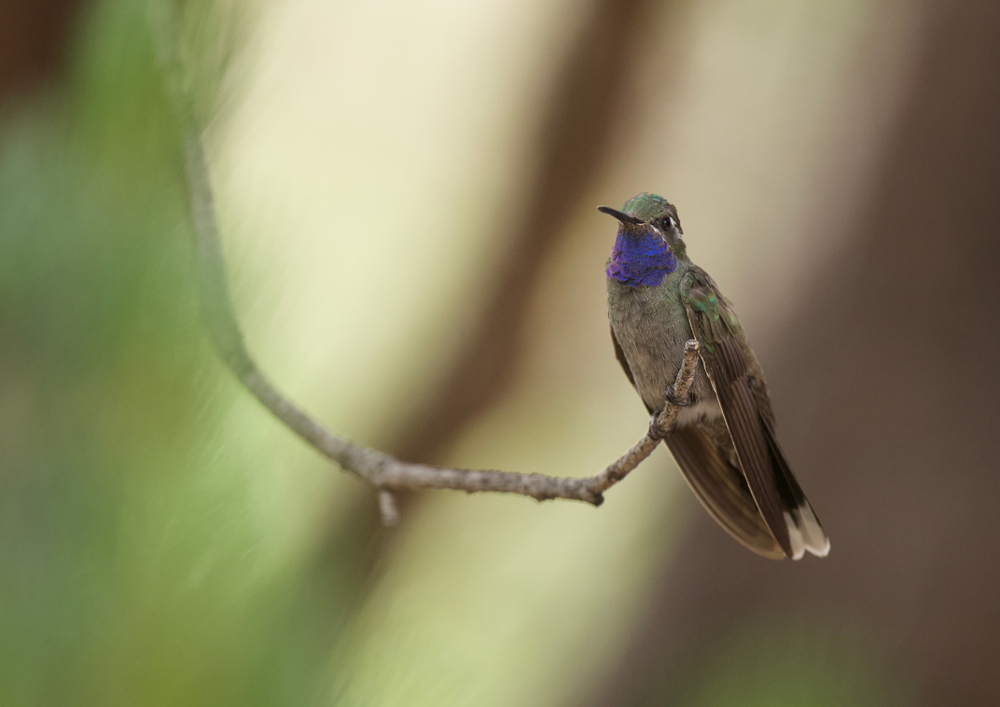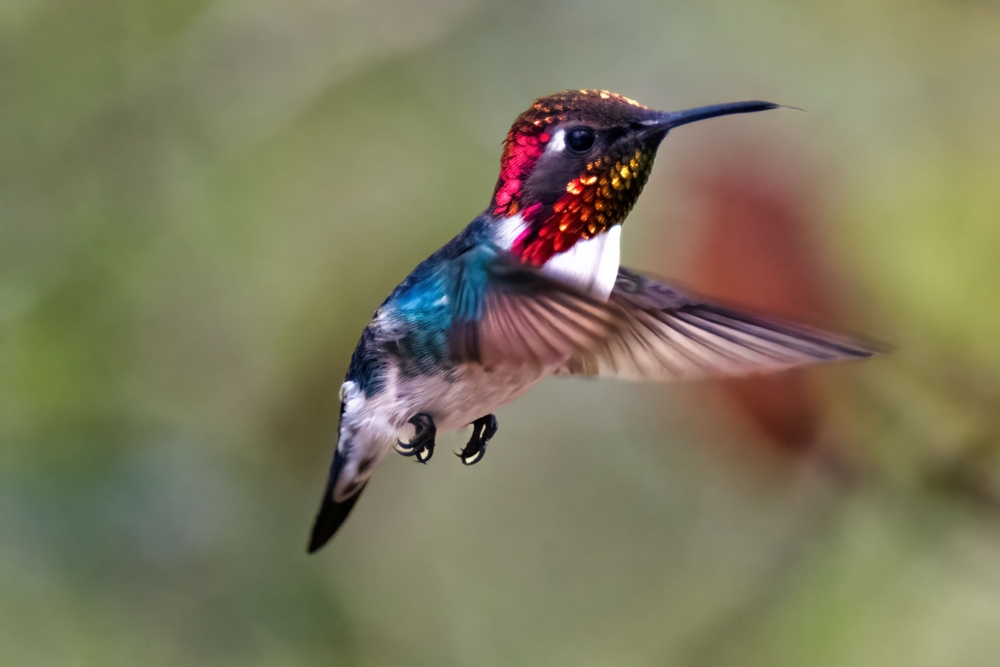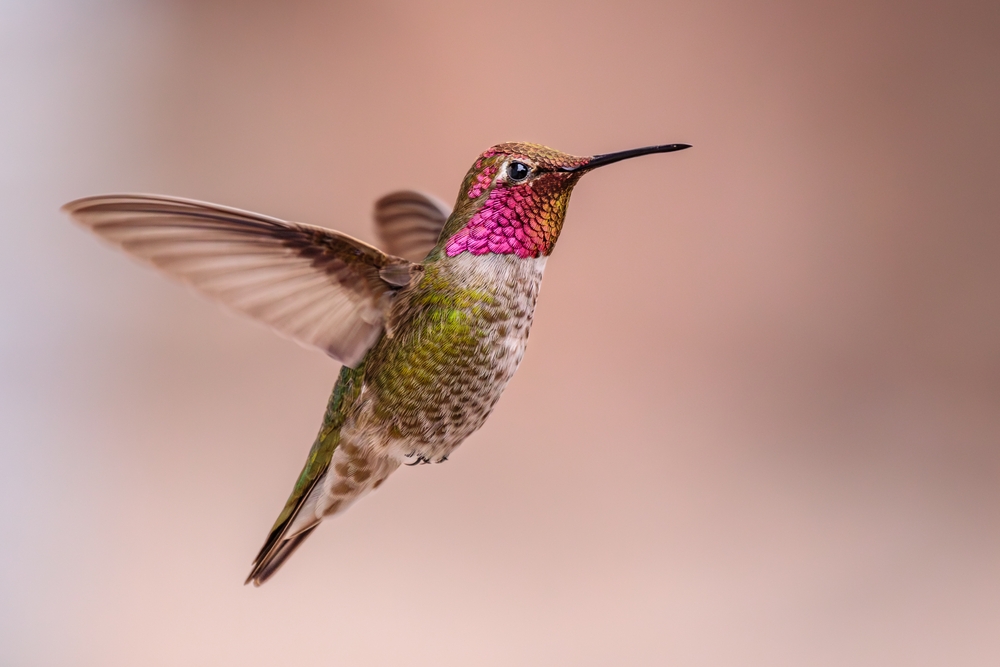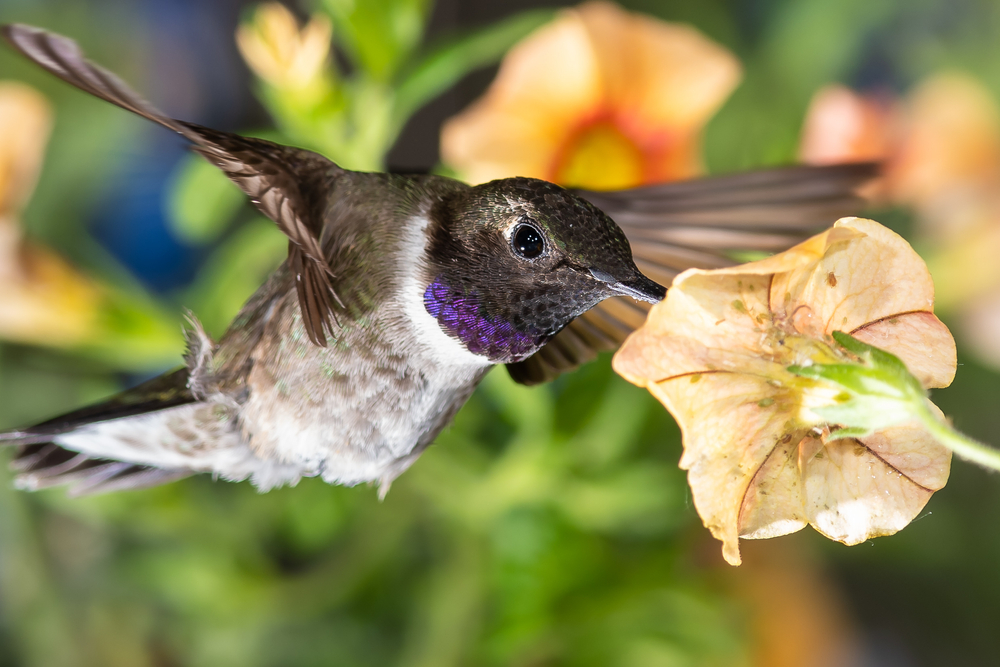The Blue-throated Mountain-gem (Lampornis clemenciae) is closely related to other hummingbirds in the Lampornis genus, especially the White-throated Mountain-gem (Lampornis castaneoventris) of Central America. They share similar size, structure, and facial markings.
About
The Blue-throated Mountain-gem (Lampornis clemenciae) is the largest hummingbird native to North America north of Mexico, belonging to the family Trochilidae. Found primarily in the montane forests and canyons of Mexico, it also ranges into the southwestern United States, especially Arizona, New Mexico, and Texas, where it inhabits shaded streamsides, oak woodlands, and pine-oak forests. Its preference for cool, forested mountain habitats distinguishes it from many other hummingbird species that favor open or desert areas.
This striking bird measures 11–12.5 cm (4.3–5 in) in length and weighs 8–10 grams, making it nearly twice the size of many other hummingbirds in its range. As its name suggests, males are adorned with a brilliant sapphire-blue throat patch (gorget), which shimmers vividly in sunlight. Both sexes display metallic green upperparts, grayish underparts, and a distinctive white stripe behind the eye. Females lack the blue throat but retain the elegant green-and-gray coloration, making them subtly beautiful.
The Blue-throated Mountain-gem feeds primarily on nectar, favoring tubular flowers found in its mountain habitats, but it also consumes insects and spiders for protein. It is a frequent visitor to feeders in its range, where its size and assertive behavior allow it to dominate smaller hummingbirds.
Breeding typically occurs in spring and summer. Males perform aerial displays and trill with their wings to attract mates. Females alone build small cup-shaped nests out of plant down and spider silk, attaching them securely to tree branches. A typical clutch consists of two small white eggs, which the female incubates and raises without male assistance.
Although its global population is considered stable, the Blue-throated Mountain-gem depends on intact montane forests and riparian habitats. Conservation of these ecosystems is critical to sustaining this jewel-toned species, admired for both its size and beauty.
Blue-throated Mountain-gem
Plumage:
The Blue-throated Mountain-gem (Lampornis clemenciae) is the largest hummingbird regularly found in North America north of Mexico, with a bold and elegant appearance.
-
Male: Striking with a brilliant iridescent sapphire-blue throat patch (gorget), metallic green back, grayish underparts, and two strong white stripes on the face (above and below the eye).
-
Female: Lacks the blue gorget but shows similar green upperparts, grayish underparts, and distinctive white facial stripes.
Head:
Males display the vivid blue gorget in sunlight, contrasting with a dark crown and face. Both sexes have a long, straight, black bill well-adapted for probing deep flowers.
Body:
Stockier and larger-bodied than most hummingbirds, with metallic green upperparts and a grayish belly. The tail is long and dark, tipped with white in both sexes.
Size:
-
Length: 4.3–5.1 in (11–13 cm)
-
Wingspan: About 5.5–6.0 in (14–15 cm)
-
Weight: 0.21–0.28 oz (6–8 g)
Feet & Tail:
Small feet used primarily for perching. The tail is relatively long and square-tipped, with white outer edges that flash during flight.
Flight Style:
Wingbeats average around 23–25 beats per second, slower than smaller hummingbirds due to their larger size. Males perform hovering courtship displays near females, showing off their shimmering blue throats.
The Blue-throated Mountain-gem’s large size, sapphire gorget, and bold white facial stripes make it one of the most distinctive hummingbirds of the southwestern U.S. and Mexico.
Reproduction
Breeding Season:
In the United States (southwestern Texas, Arizona, and New Mexico), Blue-throated Mountain-gems breed from late spring through summer (generally May to August). In Mexico and Central America, breeding may vary with local flowering seasons.
Courtship:
-
Males display their brilliant blue gorget in direct sunlight, hovering close to females to catch the light.
-
They also perform hovering flight displays, sometimes with short back-and-forth movements to show off their throat.
-
Unlike some hummingbirds, courtship is less dramatic in terms of dives, but relies heavily on color displays and vocalizations.
-
Males do not assist with nesting or chick-rearing.
Nesting:
-
The female alone builds the nest, typically in a sheltered location such as a tree branch, ledge, or occasionally near human structures like porches.
-
Nests are cup-shaped and about 2 in (5 cm) wide, made from moss, plant down, and spider silk, camouflaged with lichens.
Eggs:
-
A clutch typically contains 2 small white eggs, each about the size of a jellybean (0.5 in / 1.3 cm long).
Incubation:
-
Lasts 17 to 19 days.
-
Only the female incubates the eggs.
Chick Development:
-
Chicks hatch altricial (blind, featherless, and helpless).
-
The female feeds them regurgitated nectar and small insects, critical for protein.
-
Nestlings fledge at about 23 to 26 days, though they may continue to be fed for another week or two after leaving the nest.
Maturity:
-
Juveniles are capable of independent feeding soon after fledging.
-
Sexual maturity is typically reached at 1 year of age.
The Blue-throated Mountain-gem’s reproductive cycle is notable for its longer incubation and nestling periodscompared to many smaller hummingbirds, reflecting its larger size.
Lifespan
In the Wild:
Blue-throated Mountain-gems typically live 5 to 7 years in their montane forest habitats, though survival rates are lowest during the first year due to predation and migration challenges.
In Captivity:
With steady food, veterinary care, and no predators, they may live longer, sometimes reaching 9 to 10 years, though they are rarely kept outside of rehabilitation settings.
Record Lifespan:
The oldest recorded wild Blue-throated Mountain-gem, documented through banding studies, lived at least 7 years and 11 months.
Threats to Longevity:
-
Predation: Eggs and nestlings are vulnerable to snakes, jays, and squirrels; adults may be preyed upon by larger birds such as hawks.
-
Habitat Loss: Dependence on montane oak and pine forests makes them vulnerable to deforestation and habitat fragmentation.
-
Climate Change: Alters flowering cycles of nectar plants, directly affecting food availability.
-
Competition: Aggressive species like Rivoli’s Hummingbird and Anna’s Hummingbird may displace them at feeding territories.
Despite these challenges, the Blue-throated Mountain-gem is relatively long-lived for a hummingbird, aided by its larger size and adaptability in foraging.
Eating Habits
Diet:
The Blue-throated Mountain-gem is an omnivorous hummingbird, feeding primarily on:
-
Nectar: From a wide variety of tubular flowers, including columbine, trumpet creeper, penstemon, and agave.
-
Insects & Spiders: Small flies, gnats, aphids, and spiders, which provide protein essential for adults and chicks.
-
Sap: Occasionally visits sap wells created by sapsuckers, drinking sap and feeding on trapped insects.
Foraging Behavior:
-
Hovers in front of flowers, using its long, extendable tongue to lap nectar at high speed (up to 13 licks per second).
-
Perches frequently while feeding, unlike smaller hummingbirds that hover constantly.
-
Defends nectar-rich feeding territories aggressively, especially males, which perch prominently and chase intruders.
-
Females may forage more widely when nesting, taking advantage of both flowers and insects.
Feeding Adaptations:
-
Larger body size allows them to dominate smaller hummingbirds at feeders and flower patches.
-
Strong, straight bill enables efficient nectar extraction from deep tubular flowers.
-
Ability to catch insects midair (hawking) or glean them from foliage, supplementing their nectar-based diet.
Role in Ecosystem:
As one of the largest hummingbirds in North America, the Blue-throated Mountain-gem is an important pollinator in montane forests, transferring pollen between flowers. Their insect hunting also contributes to controlling small insect populations.
The Blue-throated Mountain-gem’s flexible feeding strategy and dominance at food sources highlight its role as both a pollinator and a top competitor among hummingbirds.
Uniqueness
Largest Hummingbird in North America:
At up to 5 in (13 cm) long, the Blue-throated Mountain-gem is the largest hummingbird species regularly found north of Mexico, towering over smaller species like the Ruby-throated or Black-chinned.
Brilliant Blue Gorget:
Males are instantly recognizable by their sapphire-blue throat patch (gorget), one of the boldest throat colors of any hummingbird in the region.
Bold White Face Stripes:
Both sexes show two strong white facial stripes, above and below the eye, a distinctive feature not seen in most North American hummingbirds.
Extended Breeding Cycle:
Compared to smaller hummingbirds, they have a longer incubation (17–19 days) and fledging period (23–26 days), reflecting their larger body size.
Vocal Hummingbird:
Unlike many hummingbirds that are nearly silent, the Blue-throated Mountain-gem is notably vocal, producing loud, sharp chip calls and songs used in territorial defense.
Montane Specialist:
They are most often found in shaded mountain canyons, pine-oak forests, and streamsides, making them more habitat-restricted than generalist hummingbirds.
The Blue-throated Mountain-gem’s combination of large size, vivid throat color, bold facial stripes, and extended nesting cycle makes it one of the most unique and charismatic hummingbirds in North America.
Be the First to Share Photos of This Species.
FAQ’s
1. What is the closest species to the Blue-throated Mountain-gem?
2. How does the Blue-throated Mountain-gem compare to other hummingbirds?
It is much larger than most North American hummingbirds, with a slower wingbeat and longer nesting cycle. Males are also unique in having a brilliant blue throat and bold white facial stripes, which set them apart from the emerald and ruby gorgets of smaller species.
3. What national parks provide the best opportunities to see a Blue-throated Mountain-gem?
In the U.S., they are best seen in Big Bend National Park (Texas) and Chiricahua National Monument (Arizona). In Mexico, excellent viewing occurs in Sierra de Manantlán Biosphere Reserve and other montane forests where pine-oak habitats dominate.








































































